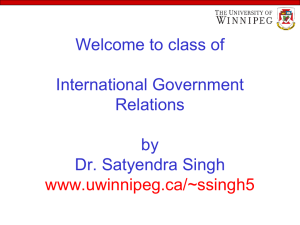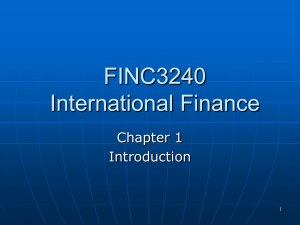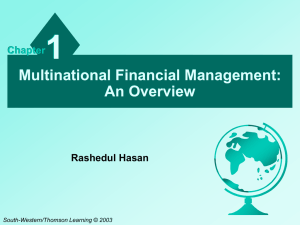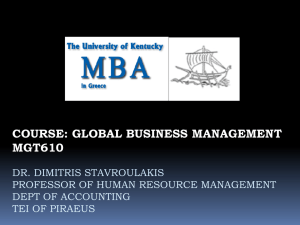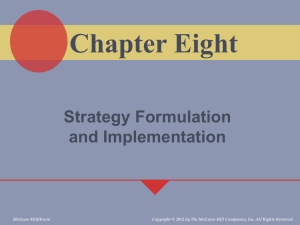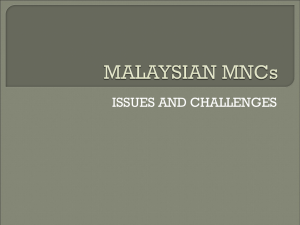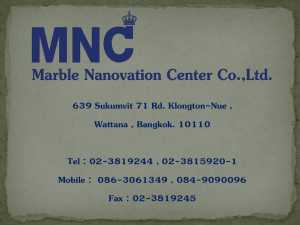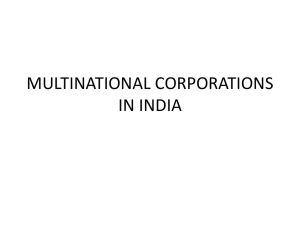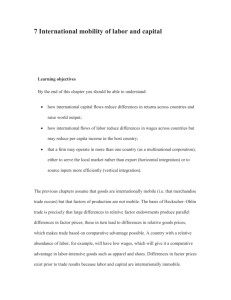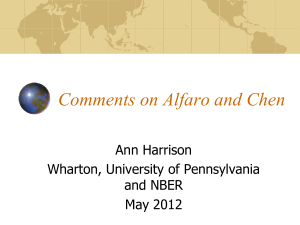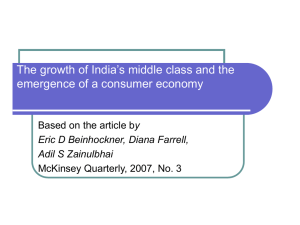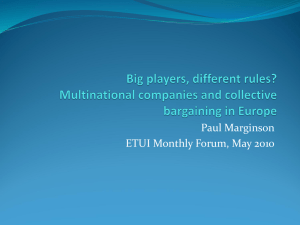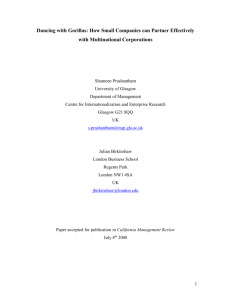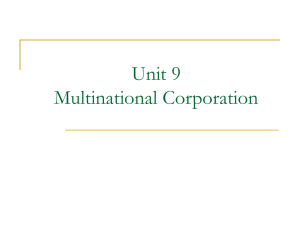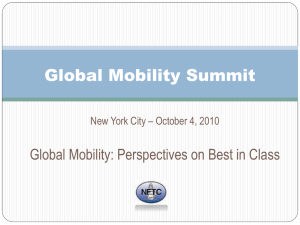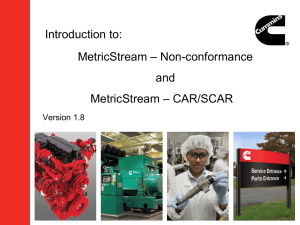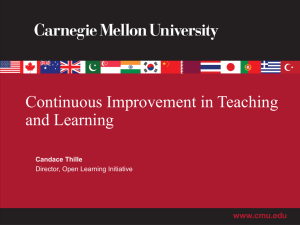Internalization - Search
advertisement
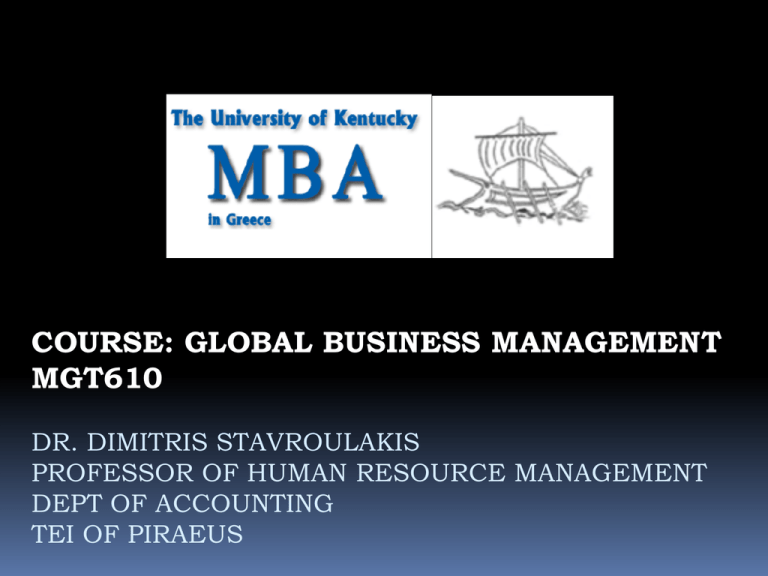
COURSE: GLOBAL BUSINESS MANAGEMENT MGT610 DR. DIMITRIS STAVROULAKIS PROFESSOR OF HUMAN RESOURCE MANAGEMENT DEPT OF ACCOUNTING TEI OF PIRAEUS Unit 6: Theoretical models underlying internationalization of business The Uppsala Internationalization Model The Internalization Model The Eclectic Paradigm The Network Model Training material: Morrison, J. (2009): International Business: Challenges in a Changing World. Palgrave MacMillan, pp 54-56. The Uppsala Internationalization Model It was introduced by Swedish scholars (Johanson & Vahlne, 1977; 1990). Distinguishes 4 stages of international expansion (the establishment chain): 1.Weak exporting activity 2.Permanent exporting activity through representatives 3.Establishment of sales divisions abroad 4.Production abroad Host countries are selected primarily according to their proximity with regard to “psychic distance”. Psychic distance is defined as “the factors preventing or disturbing firms from learning about and understanding of a foreign environment”. These factors concern mostly differences in language, culture, political systems, level of education, or level of industrial development (Johanson and Vahlne 1977). Dimensions of Distance: The CAGE Framework Prof. Ghemawat (2001) countered Friedman’s allegations about world being a “global village”. Instead, he argued that MNCs will continue to face enormous difficulties due to persisting distance between people (cultural, administrative, geographic, economic): Cultural Distance concerns different ethnicities, religions, languages, and social values. Industries most affected include food and those having linguistic content (media, TV). Size is also a cultural factor (Americans prefer big cars, Japanese small ones). In the Americas a strong demand exists for small trucks, while in Europe this does not happen. Administrative Distance refers to commercial zones, links between former colonies, diplomatic relations, government systems etc (e.g. Mexico and Spain, Portugal and Brazil). Geographic Distance influences producers of fragile & perishable goods (glass, fruit), of low value-to-weight (cement), or of high transportation costs (tourism). Economic Distance has to do with differences in development and people welfare. Most affected industries are luxury products, cars & high-tech. DISRUPTION OF EUROZONE. Country Differences? The Uppsala Internationalization Model (cont) According to the Uppsala pattern, prospective MNCs start investing in one or few neighboring countries rather than in a variety of countries simultaneously. Investment in a foreign country is carried out cautiously, gradually, and according to the learning progress of the MNC people who are employed in that market (experimental market knowledge). Thereafter, the company is expected to follow a sequence from low to high commitment and to enter new markets with successively greater psychic distance. The Uppsala model The process of internationalization according to the Uppsala model The Internalization Model Internalization: The process through which the MNC eliminates transaction costs owed to market imperfections through vertical integration. Transaction costs: If the MNC decides to buy a product or service from the market, it has to pay costs beyond its real value: 1.Search & information costs: Market search & selection. 2.Bargaining costs: Time & funds spent on reaching an acceptable agreement and elaborating the contract. 3.Policing and enforcement costs: Insurance & legal action in case of violation of the agreement. Transaction costs can be eliminated, or at least substantially reduced, if coordination of value-adding activities is carried out within one and the same firm; that is, if its operations are internalized. Internalization arises through the cost-efficient coordination of transactions of the MNC across borders. The raison d’ etre, or the competitive advantage of the MNC lies in the fact that it can handle transactions of assets more cheaply and efficiently than the market. The Internalization Model (cont) In other words, transactions carried out by the MNC are apt to be more cost-efficient than those offered by the external market (make or buy decision). If transaction costs are estimated to be low, then arms-length arrangements (occasional agreements e.g. leasing, licensing, franchising, joint ventures) are more preferable (trade-off between risk and returns). Modern corporation/MNC: “The product of a series of org innovations that have the purpose and effect of economizing on transaction costs” (Williamson, 1981) This approach is in contradiction with previous monopolistic theories which claim that MNCs expand abroad primarily in order to exploit their capacity and to offer surplus products to new markets. The Eclectic Paradigm Was developed by Prof. Dr. John Dunning, Rutgers U (1993, 2002, 2008). Attempts to interpret all stages of international expansion, from exporting till FDI. The contemporary company is viewed as fully informed about predominant conditions in international markets. Activities of MNCs are likely to be oriented to countries offering optimal combinations of preconditions described below. Different combinations of the three variables determine the modes, industries and geographical distribution of MNCs’ international operations. The Eclectic Paradigm (cont) Distinguishes 3 categories of advantages that enhance globalization of business: • Ownership Advantages • Location Advantages • Internalization Advantages From the initials, the Eclectic Paradigm is widely known as “OLI Framework”. OLI: Ownership Advantage MNCs have to possess some firm-specific competitive advantages over local firms in serving particular national markets. Ownership, or firm-specific advantages, arise from the monopoly control of tangible and intangible assets by MNCs. These often reflect the characteristics of MNCs’ home-countries. According to the Product Cycle Theory MNCs export their products abroad only after the home market becomes saturated. This normally happens at the maturity stage of the Product Life Cycle. Ownership assets: Core competencies, patents & trademarks, technology, brand name. OLI: Location Advantage It might be more profitable for MNCs to exploit their Ownership advantages by combining them with others pertaining to the exploitation of resources located outside the home country. This provides the incentive to locate some part of their activities abroad. Otherwise, MNCs could either import or outsource these inputs locally, and then serve overseas markets via exports. Location possible assets: Low cost & high quality of transportation, favorable host government policy, access to raw materials, technology & human capital. OLI: Internalisation Advantage It might be more profitable for MNCs to exploit their O&L Advantages through internalisation rather than by using arm’s-length market arrangements (occasional transactions often without a long-term orientation e.g. leasing, licensing, franchising, joint venture). On the other hand, if transaction costs are estimated to be low, then arm’s-length arrangements may prove more promising. Internalization Assets: Transaction cost benefits, internal alignment of activities, value-adding potential. The OLI Framework Location Advantage: Location Specific factors. These are external to the firm including transportation cost, government regulation, infrastructure factors OLI Ownership Advantage: Firm specific factors including technology, , patent, process, name recognition, and other core competencies Internalization: Cost advantage from vertical and horizontal integration, due to transaction cost caused by market failure Business Models Global Matrix Structure of MNCs The Head of German branch coordinates all affiliates within Germany; the Head of plastic products coordinates the Manufacturing & Sale of products worldwide. The GM of plant producing plastic containers in Germany reports to both Head of the plastic products division and to the Head of German operations. CEO Germany Plastic Products Glass Fibers Insulation Latin America Spain Introduction to the Network Model The Collapse of the Global Matrix In the 90s, the matrix structure was considered the most efficient way to combine global coordination with local responsiveness. The main advantage of matrix (compared to hierarchical structures) lies in its ability to accommodate managers with worldwide product responsibility and country managers responsible for geographic regions. In practice, however, the system did not work. Dow Chemical, a pioneer of the global matrix, eventually returned to more conventional structures with clear lines of responsibilities. Citibank, another advocate of the global matrix, discarded the system after years of much publicized experimentation. The Collapse of the Global Matrix Reasons of the collapse: Conflict & confusion due to dual reporting and overlapping responsibilities of managers. Separated by barriers of distance, culture, time, and language, managers often found it impossible to clarify confusion. Excessive time spent on compromising decisions. Duplication of information and communication, high administrative costs. Eventual emergence of one dominant decision-making center instead of two or more relevant – the matrix being abolished in practice. The Network Model The network model postulates that the MNC comprises different business actors (subs & units), albeit constituting one legal and administrative entity. MNC is viewed as an heterogeneous, loosely coupled org in which no unit, including the headquarters, possesses full control ( differentiated global network). Power is unequally distributed among subs and units. Each sub is embedded in a specific network of business relationships, distinct from the others. Each sub identifies problems and oppts in its own business network, therefore it will strive either for: Autonomy from the rest of the company, or for: Power to influence the development of other parts of the MNC in a way that supports its own network. Subs are more or less loosely coupled, and are greatly influenced by their business network actors, irrespective of whether these are located inside or outside the MNC. Simultaneous roles: Compliance with the HQ guidelines (centripetal). Development within their own business network (centrifugal). The Network Structure of the MNC The Network Model (cont) Key terms: Embedded relationships: Very close in terms of mutual adaptation of resources and activities, and knowledge exchange. It is difficult for the units or companies engaged to substitute the loss of this business relationship with a new one. Arm’s length relationships: They concern sporadic and impersonal transactions, without entailing long-term commitment of the parties involved. Business relationships are designated as flexible and opportunistic. Subs are developing both embedded and arm’s length business relationships. The network of embedded relationships does not coincide with the MNC boundaries. The essence of the network model is the blurring of company borders: Subs may develop embedded relationships with external businesses, while retaining arm’s length relationships with units inside the MNC. The Network Model (cont) Balancing role of the MNC HQ: Simply one player among others in the org. No unit, even the HQ, exercises full control. Management from the HQ involves an extensive bargaining process between conflicting needs and demands of powerful subs and units. Paradox: It is quite possible to exert a considerable amount of influence on the political decisions made in a society without having full control over the organization on which this influence is actually based. “Weak management” inside the MNC vs. strong political influence stemming from the MNC power to move capital and production along countries (exercise of economic statesmanship). Market conditions do exist inside the MNC in terms of inter-unit competition and antagonism. Since subs have a free rein, coordination of activities is enormously complicated. The HQ may have only imperfect knowledge of subs’ activities. Even when the HQ have an accurate picture, it remains unclear which activities should be coordinated and why.




